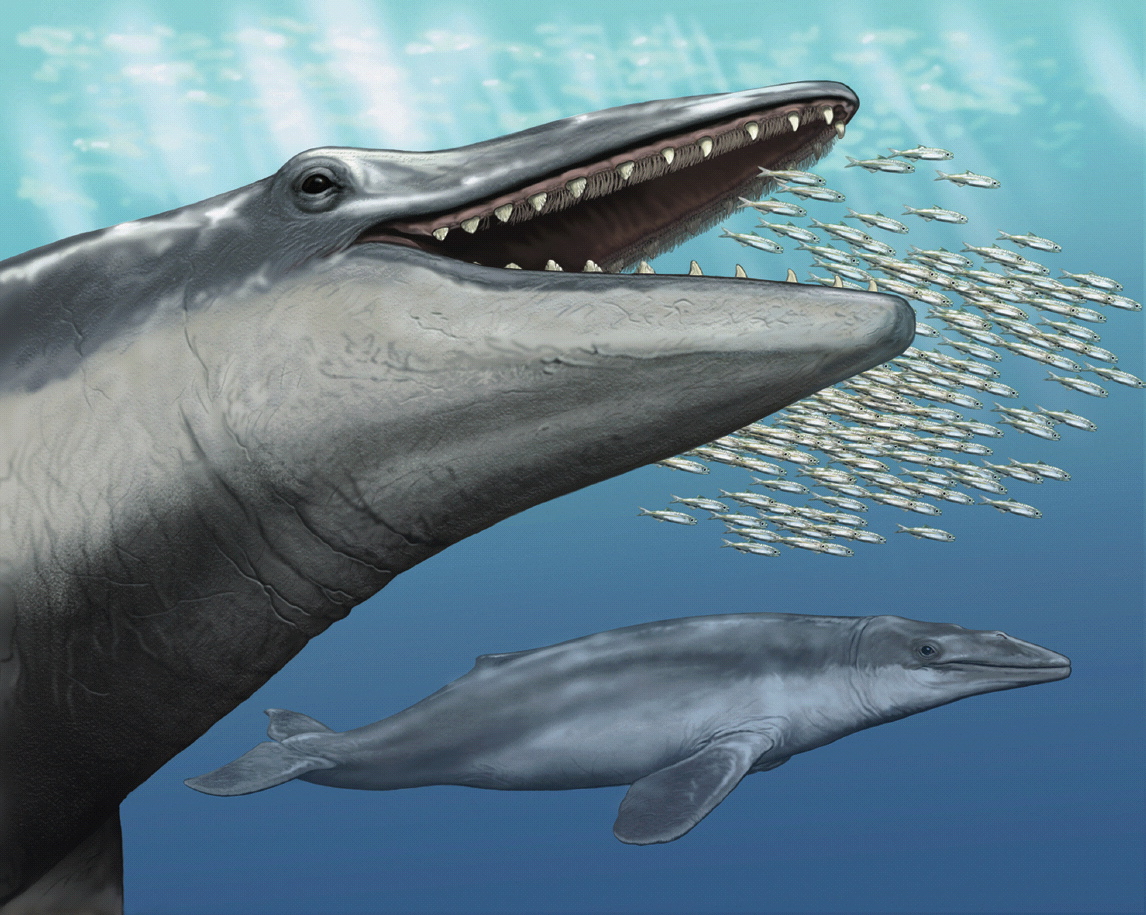Post by Infinity Blade on Jul 18, 2015 20:20:52 GMT 5
Aetiocetus spp.

Life restoration of A. weltoni displaying both teeth and baleen. © @ Carl Buell
Temporal range: Oligocene (Rupelian-Chattian: ~28-24Ma)
Scientific classification:
Life
Domain: Eukaryota
(unranked): Unikonta
(unranked): Opisthokonta
(unranked): Holozoa
(unranked): Filozoa
Kingdom: Animalia
Subkingdom: Eumetazoa
(unranked): Bilateria
Clade: Nephrozoa
Superphylum: Deuterostomia
Phylum: Chordata
Clade: Olfactores
Clade: Craniata
Subphylum: Vertebrata
Infraphylum: Gnathostomata
Clade: Eugnathostomata
Clade: Teleostomi
Superclass: Tetrapoda
Clade: Reptiliomorpha
Clade: Amniota
Clade: Synapsida
Clade: Eupelycosauria
Clade: Sphenacodontia
Clade: Sphenacodontoidea
Order: Therapsida
Suborder: Cynodontia
Clade: Epicynodontia
Infraorder: Eucynodontia
Parvorder: Probainognathia
Superfamily: Chiniquodontoidea
Clade: Prozostrodontia
Clade: Mammaliaformes
Class: Mammalia
Clade: Holotheria
Superlegion: Trechnotheria
Legion: Cladotheria
Sublegion: Zatheria
Infralegion: Tribosphenida
Subclass: Theria
Clade: Eutheria
Infraclass: Placentalia
Subcohort: Exafroplacentalia
Magnorder: Boreoeutheria
Superorder: Laurasiatheria
Clade: Ungulata
(unranked): Cetartiodactyla
Suborder: Mysticeti
Family: †Aetiocetidae
Genus: †Aetiocetus
Species: †A. cotylalveus
†A. polydentatus
†A. tomitai
†A. weltoni
Aetiocetus was a genus of mysticete that lived in the Oligocene of Japan, Mexico, and the United States (particularly in the state of Oregon)[1] from ~28-24 million years ago.[2]
Description:
Aetiocetus clearly had teeth, but upon closer inspection, the lateral areas of the palate were shown to have had nutrient foramina (groove-like structures) as well. Modern baleen whales possess nutrient foramina that provide blood vessels and nerves to form baleen. Therefore, Aetiocetus was a baleen whale that possessed both teeth and baleen and represents a transitional form between toothed baleen whales and baleen whales with baleen.[2][3]

From Deméré et al. (2008). Ventral view of the upper jaw of A. weltoni. The left image clearly shows teeth while the right image has arrows pointing to the baleen-forming structures.
Feeding:
The possession of teeth allowed for the consumption of large prey while the possession of baleen permitted the sieving of smaller quarry.[2]
References:
[1] fossilworks.org/bridge.pl?action=taxonInfo&taxon_no=36654
[2] whyevolutionistrue.wordpress.com/2010/07/22/baleen-whales-a-lovely-transitional-form/
[3] "Morphological and molecular evidence for a stepwise evolutionary transition from teeth to baleen in mysticete whales" (Deméré et al., 2008).

Life restoration of A. weltoni displaying both teeth and baleen. © @ Carl Buell
Temporal range: Oligocene (Rupelian-Chattian: ~28-24Ma)
Scientific classification:
Life
Domain: Eukaryota
(unranked): Unikonta
(unranked): Opisthokonta
(unranked): Holozoa
(unranked): Filozoa
Kingdom: Animalia
Subkingdom: Eumetazoa
(unranked): Bilateria
Clade: Nephrozoa
Superphylum: Deuterostomia
Phylum: Chordata
Clade: Olfactores
Clade: Craniata
Subphylum: Vertebrata
Infraphylum: Gnathostomata
Clade: Eugnathostomata
Clade: Teleostomi
Superclass: Tetrapoda
Clade: Reptiliomorpha
Clade: Amniota
Clade: Synapsida
Clade: Eupelycosauria
Clade: Sphenacodontia
Clade: Sphenacodontoidea
Order: Therapsida
Suborder: Cynodontia
Clade: Epicynodontia
Infraorder: Eucynodontia
Parvorder: Probainognathia
Superfamily: Chiniquodontoidea
Clade: Prozostrodontia
Clade: Mammaliaformes
Class: Mammalia
Clade: Holotheria
Superlegion: Trechnotheria
Legion: Cladotheria
Sublegion: Zatheria
Infralegion: Tribosphenida
Subclass: Theria
Clade: Eutheria
Infraclass: Placentalia
Subcohort: Exafroplacentalia
Magnorder: Boreoeutheria
Superorder: Laurasiatheria
Clade: Ungulata
(unranked): Cetartiodactyla
Suborder: Mysticeti
Family: †Aetiocetidae
Genus: †Aetiocetus
Species: †A. cotylalveus
†A. polydentatus
†A. tomitai
†A. weltoni
Aetiocetus was a genus of mysticete that lived in the Oligocene of Japan, Mexico, and the United States (particularly in the state of Oregon)[1] from ~28-24 million years ago.[2]
Description:
Aetiocetus clearly had teeth, but upon closer inspection, the lateral areas of the palate were shown to have had nutrient foramina (groove-like structures) as well. Modern baleen whales possess nutrient foramina that provide blood vessels and nerves to form baleen. Therefore, Aetiocetus was a baleen whale that possessed both teeth and baleen and represents a transitional form between toothed baleen whales and baleen whales with baleen.[2][3]

From Deméré et al. (2008). Ventral view of the upper jaw of A. weltoni. The left image clearly shows teeth while the right image has arrows pointing to the baleen-forming structures.
Feeding:
The possession of teeth allowed for the consumption of large prey while the possession of baleen permitted the sieving of smaller quarry.[2]
References:
[1] fossilworks.org/bridge.pl?action=taxonInfo&taxon_no=36654
[2] whyevolutionistrue.wordpress.com/2010/07/22/baleen-whales-a-lovely-transitional-form/
[3] "Morphological and molecular evidence for a stepwise evolutionary transition from teeth to baleen in mysticete whales" (Deméré et al., 2008).



